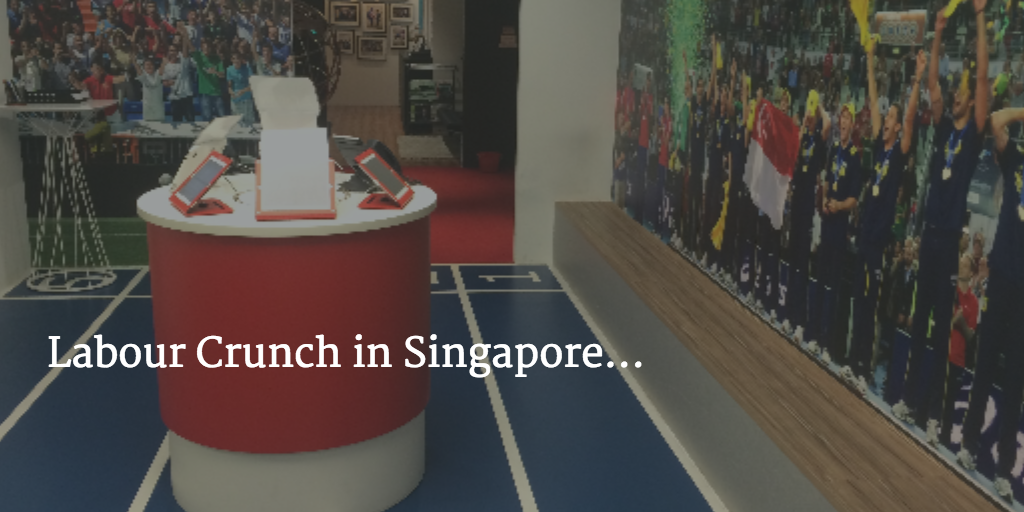 Singapore’s Changi Airport is building its fourth terminal which is scheduled to open in 2017. Terminal 4, now 70% complete, will see 16 million passengers through the year. That’s an estimated total of 82 million passengers once T4 operates in full swing. We are super excited to see what Changi has in store for us, considering Terminals 1-3 have movie theaters, a butterfly garden, a 4 storey tall slide (a.k.a the tallest slide in Singapore) and who knows what else.
Singapore’s Changi Airport is building its fourth terminal which is scheduled to open in 2017. Terminal 4, now 70% complete, will see 16 million passengers through the year. That’s an estimated total of 82 million passengers once T4 operates in full swing. We are super excited to see what Changi has in store for us, considering Terminals 1-3 have movie theaters, a butterfly garden, a 4 storey tall slide (a.k.a the tallest slide in Singapore) and who knows what else.
T4 will be a two storey building and 190, 000 square meters: the size of around 27 football pitches. This S$1.82 billion project is not just exciting for passengers. It is a massive opportunity for retailers and F&B outlets as well. With 17,000 square meters floor space devoted solely towards retail, there is plenty to look forward to. Changi has announced that the retail space will offer the most innovative design, offering customers a differentiated shopping experience.
In fact, everything about Terminal 4 is about giving commuters an enhanced experience at the airport. It starts with increasing productivity through its FAST@Changi concept. Fast And Seamless Travel (FAST) will reduce the need for manpower and increase the speed of check-in and immigration procedures. To facilitate this, Changi will have self check-in, self baggage tagging and automated baggage drop terminals. Facial recognition and biometric technology will reduce the number of security guards employed for manual visual checks at multiple checkpoints. If we haven’t said it enough before, here is another example of how technology is reducing the need for labour, saving time and money, all in one go.
Imagine entering an airport and walking straight to your gate without having to constantly pull out your boarding pass and passport to clear security checkpoints. Or if you’re anything like me, imagine all the extra time you’ve now got at duty free stores because you took just a couple of minutes checking in!
This is exactly what retail and F&B outlets are looking forward to. The FAST concept gets 16 million passengers through the doors of Terminal 4. It also gives these passengers more time on the retail floor to shop and dine. While designing the new concept, Changi switched on its ridiculously client focused side and implemented recommendations from the public on the theme. The design shows off Singapore’s local culture and heritage. The Peranakan-inspired storefront facades are just an example of what the walk – through concept at T4 will look like.
With a year and a half left till T4 opens, we know the retail space is dedicated to 80 outlets. It is still too early to tell which brands will be occupying the space. The amount of traffic that these stores will face in the initial period depends on the number of airlines that T4 will service. Changi has announced 6 airlines that will have access to T4: Cathay Pacific, AirAsia Berhad, Thai AirAsia, Indonesia AirAsia, Vietnam Airlines and Korean Air. In the year 2014, these 6 airlines added a total of 7 million passengers to the airport. A few more airlines will join these 6, resulting in an estimated 10 million passengers in the first year of operations. We’re looking forward to more updates on T4 and will keep you updated about the retail and F&B world inside T4!




 The F&B sector is facing a labour crunch. Restaurants are turning away diners even though they have empty tables because they are understaffed. This has been a problem in Singapore, but never more serious than now. Singapore’s unemployment rate is at a stunning 1.9%. The turnover rate in the F&B business is the
The F&B sector is facing a labour crunch. Restaurants are turning away diners even though they have empty tables because they are understaffed. This has been a problem in Singapore, but never more serious than now. Singapore’s unemployment rate is at a stunning 1.9%. The turnover rate in the F&B business is the 
